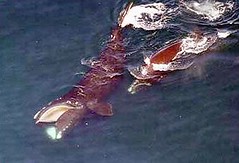 由美國國家海洋暨大氣總署(NOAA)主導的科學團隊發現,瀕臨絕種的北大西洋露脊鯨,即便生活在保護區內,仍因為主要由船隻造成的背景噪音,造成牠們和同伴溝通的能力受到損害達2/3,宛如陷入「噪聲迷霧」(acoustic smog)。
由美國國家海洋暨大氣總署(NOAA)主導的科學團隊發現,瀕臨絕種的北大西洋露脊鯨,即便生活在保護區內,仍因為主要由船隻造成的背景噪音,造成牠們和同伴溝通的能力受到損害達2/3,宛如陷入「噪聲迷霧」(acoustic smog)。
從2007年到2010年,來自Stellwagen珊瑚岩礁國家海洋保護區、康乃爾鳥類學實驗室、NOAA東北漁業科學中心及海洋聲學公司(Marine Acoustics Inc)的科學家,使用水下錄音設備陣列來監測噪音程度,衡量不同程度的聲音與船舶間的關連,並紀錄不同種類的鬚鯨所發出的獨特聲音;這些聲音中包括了北大西洋露脊鯨為了聯繫彼此發出的鳴唱。
在研究計畫當中,NOAA東北漁業科學中心2008年4月紀錄了超過22000筆北大西洋露脊鯨的聯繫鳴唱資料,藉由康乃爾大學及海洋聲學公司建立的軟體分析研究區的船舶噪音傳播。另外,也利用由美國海岸防衛隊自動辨識系統得來的船隻追蹤資料,用來計算棲地內外的船舶噪音。
透過比較現今商業船隊噪音與半個世紀前的噪音情境,研究者估計平均而言,露脊鯨喪失了棲地及周遭水域63-67%的溝通空間。
本研究主要作者、海洋生態學者Leila Hatch 博士表示:「這就像是一個只依靠聲音在他的社區安全移動的盲人,他的社區卻位在一個吵雜的機場旁。」
「如露脊鯨這樣大型的鯨類依賴牠們的聽覺遠超過視覺,長期的噪音環境將會降低牠們獲得關於食物、尋覓配偶、導航、避開獵食者及照顧幼鯨等資訊的能力。」
北大西洋露脊鯨在北美洲東岸的活動範圍,北自加拿大新斯科細亞省、南至美國佛羅里達州。牠們是世界上最稀有的瀕臨滅絕大型動物。近期對牠們族群量的估計約在350-550隻間。
康乃爾大學的生物聲學研究計劃主任、本研究的共同作者Christopher Clark博士表示,「研究成果呈現,僅一艘船隻製造的噪音足以使得一隻露脊鯨無法聽到其他鯨魚的聲音。」
Clark說,「我們在這裡呈現的是,相較於40-50年前,現今在波士頓外海由船舶累積的噪音量使得生活在此區的露脊鯨多數時間難以聽到彼此。基本上,住在波士頓外的鯨魚會發現他們生活在噪聲迷霧中。」
研究者建議,應尋求全方位的離岸人類活動管理計畫,並考量長期和廣泛的噪音對海洋物種及其棲地的累積效應的影響。
國家海洋署代表Holly Bamford表示:「我們已經開始量化人為、長期噪音對海洋動物的影響。現在我們要問的是,我們如何改進我們的管理工具來更有效的解決這些問題。」
High levels of background noise, mainly from ships, have reduced the ability of critically endangered North Atlantic right whales in a marine sanctuary to communicate with each other by about two-thirds.
The scientific team was led by researchers with the National Oceanic and Atmospheric Administration, NOAA.
From 2007 until 2010, scientists from Stellwagen Bank National Marine Sanctuary, Cornell Lab of Ornithology, NOAA Fisheries Northeast Fisheries Science Center, and Marine Acoustics Inc. used an array of acoustic recorders to monitor noise levels, measure levels of sound associated with vessels, and to record distinctive sounds made by multiple species of endangered baleen whales. These included “up-calls” made by right whales to maintain contact with each other.
NOAA Fisheries Northeast Fisheries Science Center documented more than 22,000 right whale contact calls as part of the study during April 2008. Software developed by Cornell and Marine Acoustics Inc. of Arlington, Virgina aided in modeling ship noise propagation throughout the study area.
Vessel-tracking data from the U.S. Coast Guard’s Automatic Identification System was used to calculate noise from vessels inside and outside the sanctuary.
By comparing noise levels from commercial ships today with historically lower noise conditions nearly a half-century ago, the authors estimate that right whales have lost, on average, 63 to 67 percent of their communication space in the sanctuary and surrounding waters.
“A good analogy would be a visually impaired person, who relies on hearing to move safely within their community, which is located near a noisy airport,” said Leila Hatch, Ph.D., NOAA’s Stellwagen Bank National Marine Sanctuary marine ecologist and lead author of the paper.
“Large whales, such as right whales, rely on their ability to hear far more than their ability to see. Chronic noise is likely reducing their opportunities to gather and share vital information that helps them find food and mates, navigate, avoid predators and take care of their young.”
North Atlantic right whales, which live along North America’s east coast from Nova Scotia to Florida, are one of the world’s rarest large animals and are on the brink of extinction. Recent estimates put the population of North Atlantic right whales at approximately 350 to 550 animals.
“We had already shown that the noise from an individual ship could make it nearly impossible for a right whale to be heard by other whales,” said Christopher Clark, Ph.D., director of Cornell’s bioacoustics research program and a co-author of the work.
“What we’ve shown here is that in today’s ocean off Boston, compared to 40 or 50 years ago, the cumulative noise from all the shipping traffic is making it difficult for all the right whales in the area to hear each other most of the time, not just once in a while,” said Clark. “Basically, the whales off Boston now find themselves living in a world full of our acoustic smog.”
The authors suggest that the impacts of chronic and wide-ranging noise should be incorporated into comprehensive plans that seek to manage the cumulative effects of offshore human activities on marine species and their habitats.
“We are starting to quantify the implication of chronic, human-created ocean noise for marine animals,” said Holly Bamford, deputy assistant administrator of the National Ocean Service. “Now, we need to ask how we can adapt our management tools to better address these problems.”
※ 全文及圖片詳見 Environmnet News Service





